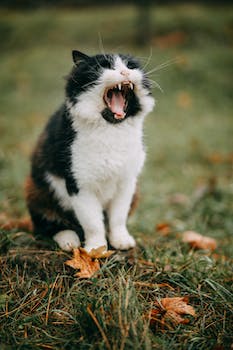

-
Table of Contents
Discover the captivating world of feline wonders.
Introduction
Cats are one of the most popular pets worldwide, known for their independent nature and mysterious behavior. However, there are many fascinating facts about cats that go beyond their adorable appearance. From their unique physical abilities to their intriguing history, cats have captivated humans for centuries. In this article, we will explore some of the most intriguing and lesser-known facts about these enigmatic creatures.
The Ancient History of Cats: Exploring their Origins and Domestication
Cats have been a beloved companion to humans for thousands of years, but their origins and domestication remain a fascinating topic of study. The ancient history of cats is a captivating journey that takes us back to the time when these enigmatic creatures first entered our lives.
The story of cats begins in ancient Egypt, where they were revered as sacred animals. The Egyptians believed that cats possessed magical powers and considered them to be the embodiment of the goddess Bastet. Cats were so highly regarded that killing one, even accidentally, was a crime punishable by death. They were often depicted in ancient Egyptian art and were even mummified alongside their owners to accompany them into the afterlife.
While Egypt is often associated with the early domestication of cats, recent archaeological discoveries have revealed that cats were also present in other parts of the world. In Cyprus, for example, a cat was found buried alongside a human in a grave dating back to 7500 BC. This suggests that cats were already living in close proximity to humans long before they were officially domesticated.
The domestication of cats is believed to have occurred around 4,000 years ago in the Near East. Unlike dogs, which were actively bred for specific traits, cats are thought to have domesticated themselves. As humans began to settle in agricultural communities, they unintentionally created an environment that was attractive to cats. The presence of grain stores attracted rodents, which in turn attracted wild cats looking for an easy meal. Over time, these cats became more comfortable living in close proximity to humans, and a mutually beneficial relationship developed.
The ancient Egyptians were not the only civilization to appreciate the value of cats. In ancient Rome, cats were highly regarded for their ability to catch mice and rats, which were a common problem in cities. They were even used to protect valuable manuscripts in libraries. The Romans believed that cats brought good luck and prosperity, and they were often depicted in art and literature.
As trade routes expanded, cats began to spread to different parts of the world. Phoenician traders, for example, are believed to have introduced cats to Europe, where they quickly became popular. In Norse mythology, the goddess Freyja was said to have a chariot pulled by two large cats. Cats were also highly regarded in ancient China, where they were believed to bring good fortune and were often kept in temples.
Despite their widespread popularity, cats faced persecution during the Middle Ages. They were associated with witchcraft and were often killed alongside their owners during the infamous witch trials. However, their reputation eventually improved, and by the 18th century, cats were once again cherished companions.
In conclusion, the ancient history of cats is a captivating tale that spans thousands of years and multiple civilizations. From their sacred status in ancient Egypt to their association with witchcraft during the Middle Ages, cats have played a significant role in human culture. Their domestication is a testament to their adaptability and their ability to forge a unique bond with humans. Today, cats continue to captivate us with their mysterious nature and independent spirit, reminding us of their ancient origins.
Unraveling the Mysterious Behaviors of Cats: Understanding their Communication and Body Language

Cats have long been a source of fascination for humans. Their mysterious behaviors and enigmatic body language have captivated our attention for centuries. Understanding how cats communicate and express themselves through their body language can provide valuable insights into their thoughts and emotions. In this article, we will unravel some of the most fascinating facts about cats, shedding light on their communication methods and the hidden meanings behind their gestures.
One of the most intriguing aspects of cat behavior is their use of body language to convey messages. Unlike humans, who primarily rely on verbal communication, cats use a combination of vocalizations, facial expressions, and body postures to express themselves. For example, when a cat arches its back and raises its fur, it is a clear sign of aggression or fear. On the other hand, a relaxed and loose body posture indicates contentment and relaxation.
Another interesting fact about cats is their ability to communicate through their eyes. Cats have a wide range of eye expressions that can convey various emotions. When a cat stares directly into your eyes with dilated pupils, it is a sign of trust and affection. However, if a cat's pupils are constricted, it may indicate fear or aggression. Understanding these subtle cues can help us better understand our feline companions and strengthen our bond with them.
Furthermore, cats communicate through their tails. The position and movement of a cat's tail can reveal a lot about its mood and intentions. A tail held high and straight signifies confidence and happiness, while a tail tucked between the legs indicates fear or submission. Additionally, a twitching tail can be a sign of excitement or irritation. By paying attention to these tail signals, we can decipher what our cats are trying to communicate to us.
In addition to body language, cats also communicate through vocalizations. While most people are familiar with the typical "meow" sound, cats have a wide repertoire of vocalizations that they use to express different needs and emotions. For instance, a short and high-pitched meow is often a greeting or a request for attention, while a long and low growl is a warning sign of aggression. By listening closely to the different sounds our cats make, we can better understand their needs and respond accordingly.
Interestingly, cats also communicate through scent marking. They have scent glands located on various parts of their bodies, including their cheeks, paws, and tails. By rubbing against objects or people, cats leave behind their unique scent, marking their territory and communicating with other cats. This behavior is not only a way for cats to establish their presence but also a means of conveying information to other felines in the area.
In conclusion, cats have a complex and fascinating system of communication and body language. By understanding the hidden meanings behind their gestures, facial expressions, and vocalizations, we can gain valuable insights into their thoughts and emotions. Whether it's through their eyes, tails, or scent marking, cats have developed unique ways to express themselves and interact with their environment. By paying attention to these subtle cues, we can deepen our understanding of our feline companions and strengthen our bond with them.
Cat Superpowers Revealed: Astonishing Abilities and Senses of our Feline Friends
Cats have long been admired for their grace, agility, and mysterious nature. These fascinating creatures possess a range of superpowers that make them truly unique among the animal kingdom. From their astonishing abilities to their heightened senses, cats continue to captivate and intrigue us. In this article, we will explore some of the most remarkable superpowers of our feline friends.
One of the most astonishing abilities of cats is their incredible agility. Cats are known for their ability to effortlessly leap and climb, often reaching heights that seem impossible for their small size. This is due to their flexible spines and powerful leg muscles, which allow them to jump up to six times their body length. Whether it's scaling trees or pouncing on prey, cats' agility is truly a sight to behold.
In addition to their physical prowess, cats possess an extraordinary sense of balance. This is thanks to their inner ear, which contains specialized structures that help them maintain equilibrium. This enables cats to walk along narrow ledges and navigate treacherous terrain with ease. Their exceptional balance also allows them to land on their feet when falling from great heights, a phenomenon known as the "righting reflex."
Cats are also renowned for their exceptional night vision. Their eyes contain a high concentration of rod cells, which are responsible for detecting low levels of light. This gives cats the ability to see in almost total darkness, making them highly efficient hunters during the night. In fact, their night vision is so superior that they can detect movement up to six times faster than humans.
Another remarkable sense possessed by cats is their acute hearing. Cats have highly sensitive ears that can detect a wide range of frequencies, including ultrasonic sounds that are inaudible to humans. This allows them to hear the faintest rustle of prey or the softest footsteps from a distance. Their ability to pinpoint the source of a sound with great accuracy makes them excellent hunters and helps them avoid potential dangers.
Cats also possess an extraordinary sense of smell. While not as developed as that of dogs, cats' olfactory abilities are still impressive. They have a specialized organ called the Jacobson's organ, located in the roof of their mouth, which allows them to detect and analyze scents in a way that humans cannot comprehend. This heightened sense of smell helps cats navigate their environment, locate prey, and even communicate with other cats through scent marking.
Lastly, cats have an uncanny ability to sense changes in the weather. They can detect shifts in atmospheric pressure and humidity, which often precede storms or other weather events. This sensitivity to weather changes is believed to be linked to their acute hearing and heightened senses overall. It's not uncommon to see cats behaving differently or seeking shelter before a storm arrives, showcasing their remarkable ability to anticipate changes in their environment.
In conclusion, cats possess a range of superpowers that make them truly extraordinary creatures. From their incredible agility and balance to their heightened senses of sight, hearing, and smell, cats continue to amaze us with their astonishing abilities. These feline superpowers are a testament to the remarkable adaptations that have allowed cats to thrive in various environments throughout history. So the next time you observe your cat in action, take a moment to appreciate the incredible superpowers that lie within this enigmatic and captivating creature.
Q&A
1. How many muscles do cats have in their ears?
Cats have 32 muscles in their ears.
2. What is the average lifespan of a domestic cat?
The average lifespan of a domestic cat is around 15 years.
3. How many whiskers does a cat typically have?
A cat typically has around 24 whiskers, 12 on each side of its face.
Conclusion
In conclusion, cats are fascinating creatures with a rich history and unique characteristics. They have been domesticated for thousands of years and have played important roles in various cultures around the world. Cats possess incredible physical abilities, such as their exceptional agility and night vision. They also have a complex communication system that includes a wide range of vocalizations and body language. Additionally, cats have been associated with numerous superstitions and beliefs throughout history. Overall, cats continue to captivate and intrigue us with their mysterious and enchanting nature.












